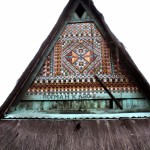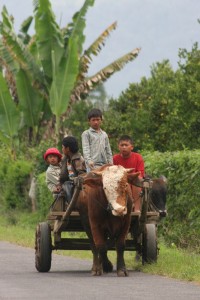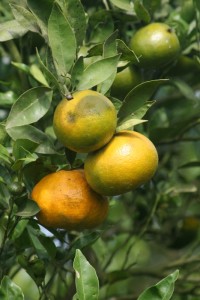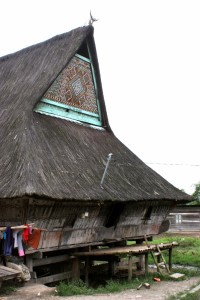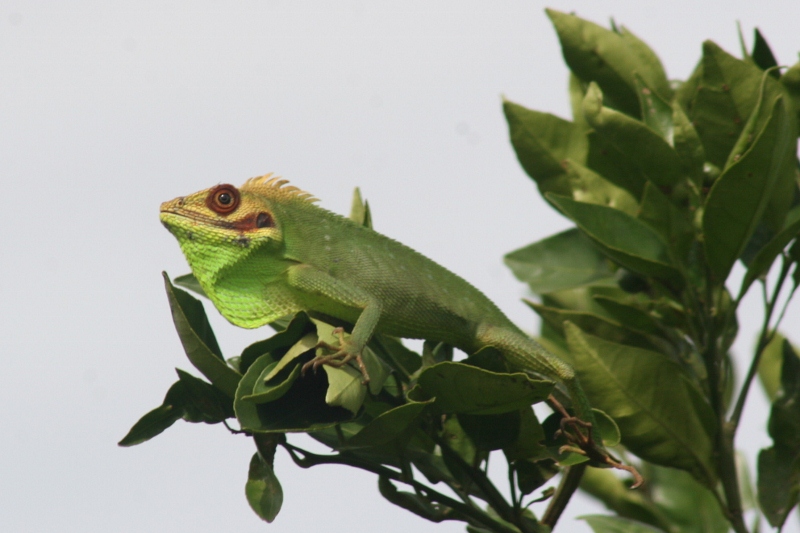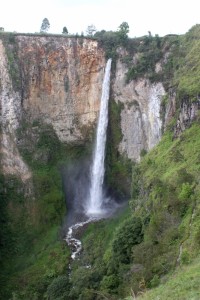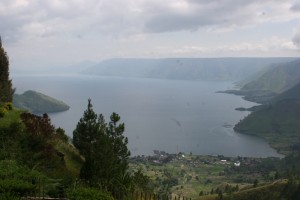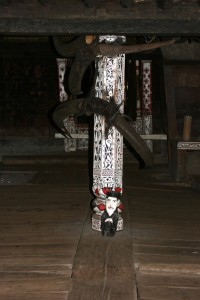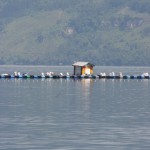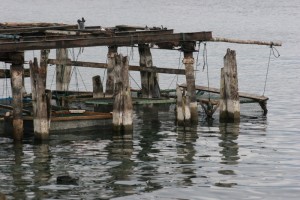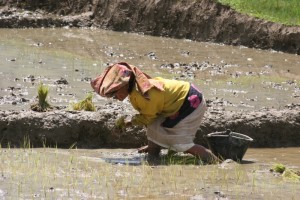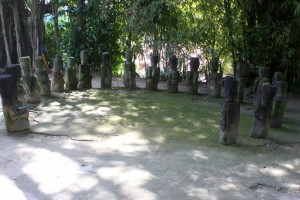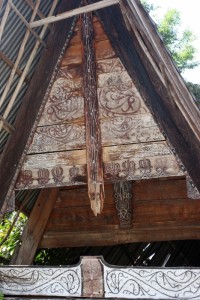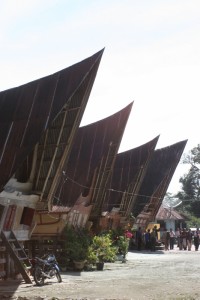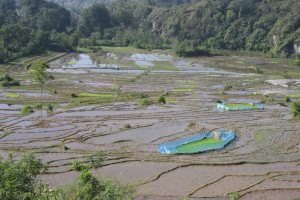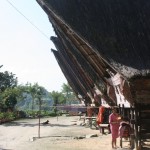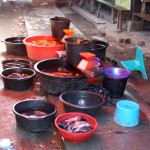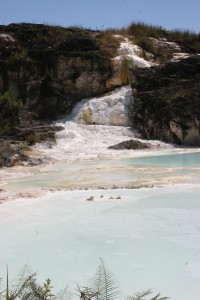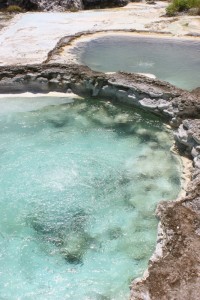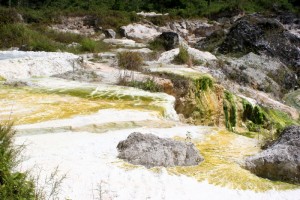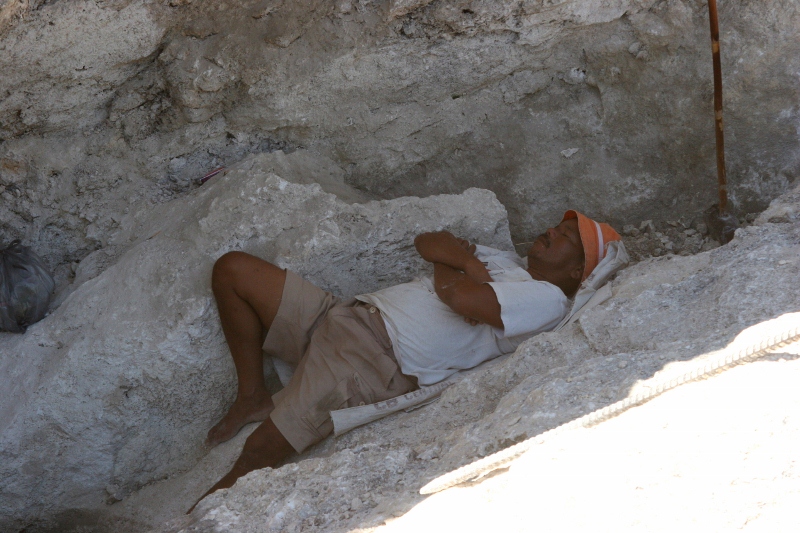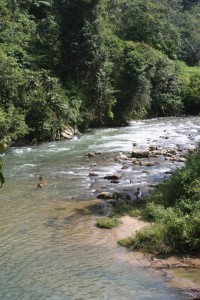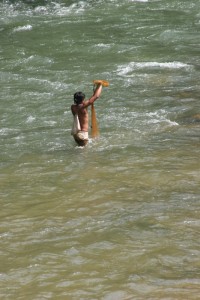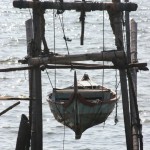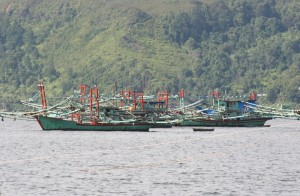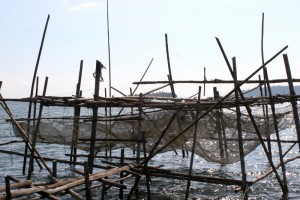Via the village of Dokan and a Batak palace to Samosir in Lake Toba, with its stone sculptures and sarcophagi, and then on to the market of Balige and the fishing communities of Sibolga
On the way to Lake Toba there is another well-kept Karo Batak village, called Dokan, which we approached after having tried the houses in Cingkes, which were totally dilapidated. The drive, through more clementine country again, was beautiful, with all the various shades of green complementing the orange bundles, and the plentiful flowers in red, yellow, pink and purple. And Dokan was a delight, with at least half a dozen Rumah Adats still in full use, and in excellent state of repair.
At the head of Lake Toba, the view of which, in the cloudy distance, was somewhat less impressive than all the tourist brochures and guide books had made me believe, is the Sipiso-Piso waterfall, a pretty narrow waterfall, but high enough to convince me not to walk all the way to the bottom. The weather did not turn better; it continued to be misty and it occasionally rained. A little further is an old Batak palace, occupied by one of the royal families before independence, but subsequently acquired by the state. Sukarno’s Indonesia was not as generous to its royals as India was, and confiscated the place to turn it into a museum. A nice enough collection of longhouses in excellent condition. Incidentally, the architectural style here is somewhat different from the previous houses, as we have now entered the area of the Simalungun Batak, as opposed to the Karo Batak we have encountered so far. In fact there are six Batak language groups, spread all over the central highlands of Northern Sumatra.
From Parapet the ferry leaves to prosaically named Tuktuk, the main town and tourist center on Pulau Samosir, the island in the middle of Lake Toba. With fewer tourists, ferry schedules have also been adjusted, leaving me for two hours in a café in Parapet, not the most exciting place to be on a rainy Monday afternoon: there is absolutely nothing to do here.
Lake Toba is a major tourist attraction, and my first impression, as so often, was “highly overrated”. The weather didn’t help of course, and neither did the army of touts who started hassling tourists in Parapet and continued on the ferry, the only way to loose them was to state that you already have a booking, and yes, with all meals included, thank you.
But by the next morning, with a clear sky and the early morning sun, the lake was indeed beautiful, steep mountains surrounding it. Samosir, the island, is the size of Singapore, but there the comparison stops. It does not support more than a handful of villages and only a rudimentary road system. Having left the car thus on the mainland, I rented a bicycle – pretty uncomfortable, given my length and the limited height of the bike, even with the saddle at its maximum height, the saddle being rather uncomfortable in its own right. The first part was easy, all downhill, and only later I realized that not only everything that goes up has to come down once again, but also the other way around – another, much more painful experience. In reality, cycling on Samosir is not particularly stressful, everything is close, and there are so many reasons to get off the bike and take pictures that you never cycle for more than 10 minutes at the time – at least I didn’t.
Tomok, for instance, is no more than half an hour south. The village itself gains its notoriety from the kings that have been buried here, but there are also a number of Batak houses – Toba Batak this time -, made from solid wood, and intricately carved gable triangles, even though the roofs are corrugated iron, these days.
The village on the other side of Tuk Tuk, equally easily reached, is Ambarita, a little disappointing except for the collection of stone chairs here, but riding back to Tuktuk, following the lake shore around the small peninsula, was delightful again, with the best views of the lake so far – as well as a sample of the accommodation of offer, and the selection of shops. Mixed business models seem the way to go here, having a hotel must be combined with a restaurant, and shops need to sell everything possible, soft drinks and alcohol as well as biscuits, souvenirs, blankets, woodcarvings and artifacts. With more time on hand Samosir is ideal for mild trekking, but my time was up, and I continued back to the mainland – well, the relative mainland of Sumatra.
There is a special quality in arriving by ferry, especially early in the morning, unhurried, slowly approaching the shore, houses lazily getting closer, and bigger, all very peaceful. Even Parapet looked attractive, in the morning. Heading east, along the Trans-Sumatran Highway, we were soon back on the village trail, the last of the Batak lot. Jangga was a little touristic, and not very special, although the surroundings made up for this.
Balige has a huge market, but most of it is indoors, and as markets go, they get less attractive the more organised they are. The town is also remarkable for the change in means of transport, gone are the becaks and in come the scooters, a major progress from chain- to axle-driven.
Just before Tarutung I ran into another surprise, again completely ignored by guide books: a large sulphur spring, sort of Indonesia’s own Pamukele. It announced itself through the smell, and I feel for all the people in the small village at its base – who have hot water all year around, but not for washing! Climbing up into the hills soon the white and yellow cones appeared, with water cascading down, and a little further I found the pools, with water bubbling to the surface in multiple places. Unlike Pamukele, this site is totally undeveloped, apart from the crews winning the sulphur, but even they don’t work that hard.
There is a shortcut from Tarutung to Padangsidempuan, through the mountains, but as I wanted to see the sea again, and the fishing villages around Sibolga, we continued to the coast. A pretty road, through densely vegetated hills, but without much of a view because of the narrow valleys and the huge ferns on both sides, before the steep drop to Sibolga.
The town itself it fairly nondescript, not very attractive, but on both ends there are large fishing communities, living in complex neighbourhoods built on stilts, and extending far into the sea, a sharp contracts with the relative modernity of the town. Obviously fishing is big business here, and there are some huge boats moored offshore, nothing like the small vessels associated with the Indonesian fishing villages I have seen so far.
A few hours further down the road was Padangsidempuan, another largish and modern town, except that the only reasonable hotel in town was still a dump, and vastly overpriced, almost deserted except for the mosquitoes. Lowlight of the evening, in an empty restaurant, must surely be that the hotel had run out of beer.
Next is to Bukittinggi.

